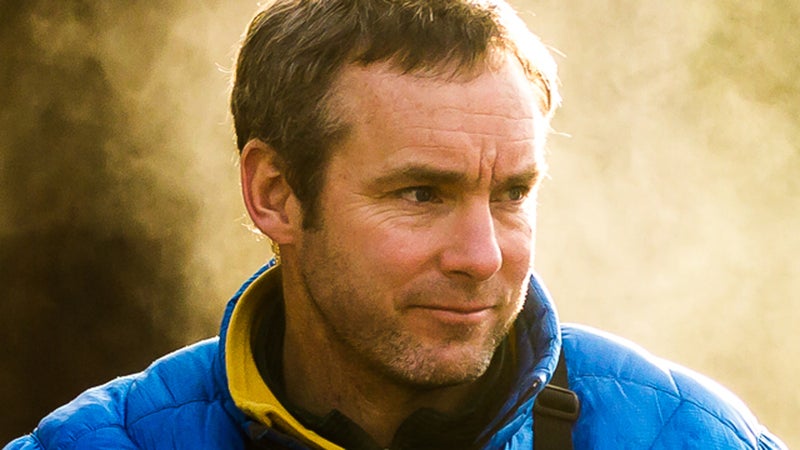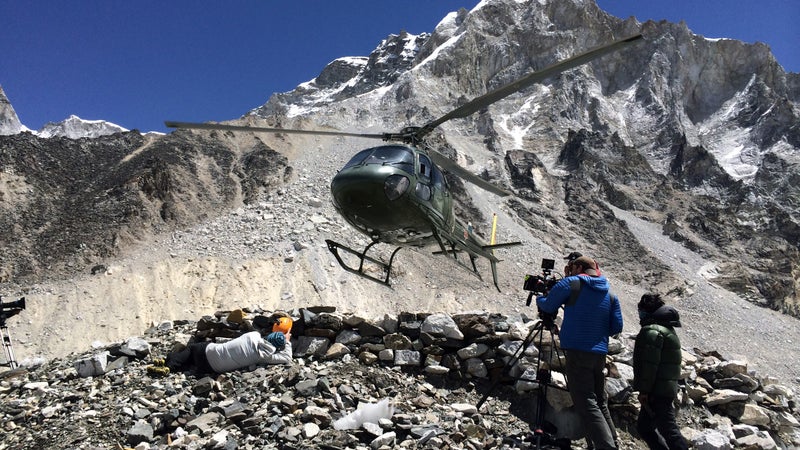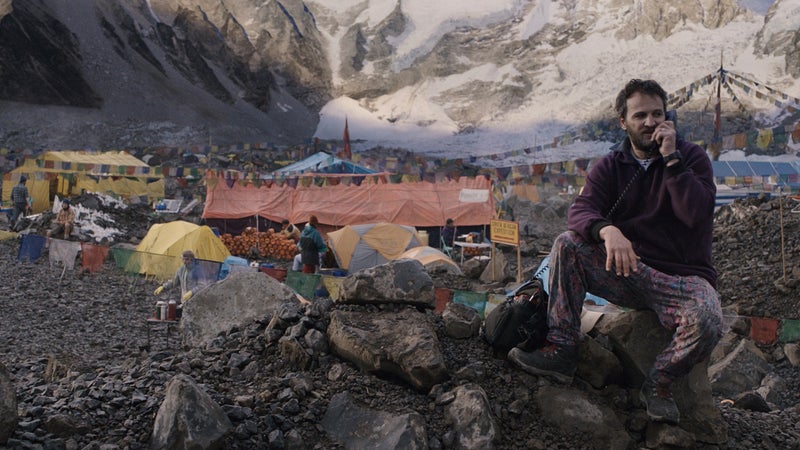When an office-building-sized block of ice in the Khumbu Icefall dislodged during the 2014 Himalaya climbing season, killing 16 high-altitude workers on the worldŌĆÖs tallest peak, had been at Base Camp for nearly two weeks. He and a team of handpicked mountaineer-filmmakers were acclimatizingŌĆöpreparing to haul up camera equipment to capture footage for this yearŌĆÖs blockbuster movie, Everest, which hits theaters Friday.
Harvey is the second unit director of photography on the film, and he was tasked with retrieving establishing shots of the icy, Himalayan environmentŌĆöEverestŌĆÖs telltale ridges, the South Col, the Hillary Step, even the summit, if he could get a camera up there. The Icefall collapse neutralized the 2014 climbing season, turning back dozens of eager climbers. But after the tragedy, Harvey and his team, led by New Zealand expedition company , managed a trip above Base Camp, into the Icefall. ŌĆ£We spent two hours getting visuals for the effects team,ŌĆØ he said.
The material they shot, combined with older footage and historic photos of the mountain and some shots in ItalyŌĆÖs Dolomites, help lay the foundation for the sweeping, computer enhanced imagery that is so crucial to selling a film of this magnitude to audiences. You want to know why Everest looks true to form? Harvey is a big reason.

Twenty years ago, Harvey, now 48, worked as a mountain guide in Colorado and as a cameraman on Warren Miller ski films. His specialty is planning, staging, and capturing elaborate action sequences on camera. His big break came about ten years ago, when he was hired to film a tricky rock climbing shot for the Brad Pitt-Angelina Jolie movie, Mr. And Mrs. Smith. (The shot didnŌĆÖt make the final cut.) It led him to working on Hollywood films and, in the past decade, heŌĆÖs been on a tear, shooting for Iron Man, The Bourne Legacy, Lone SurvivorŌĆöhe just finished work on the next Captain America Š▒▓į▓§│┘▓╣▒¶▒¶│Š▒▓į│┘.╠²
In the process, Harvey has developed a reputation as a durable dude. On Lone Survivor, for example, he dangled from a rope just off of a 40-foot-high rock face to film a stunt man, portraying a Navy SEAL, performing a high-risk shoulder-roll off the top of the cliff. ŌĆ£ThatŌĆÖs a shot you donŌĆÖt want to screw up,ŌĆØ Harvey says.┬Ā
ŌĆ£Being out in remote locations around the world, shooting ski action, taught me to be resourceful, to work in a sort of guerilla-style fashion,ŌĆØ he adds. ŌĆ£I have a pretty high suffer thresholdŌĆöa lot of people in Hollywood need the craft services.ŌĆØ
Harvey is currently enjoying some much-needed downtime at home in Denver with his wife and two young daughters. We caught up with him to talk about working with Hollywood stars at altitude and how Everest came together.
OUTSIDE: Why is mountaineering experience so important in an era when they can just render all the dangerous stuff using computer graphics?
HARVEY: I was in charge of shooting some action sequences and stunt work in the Dolomites, which doubled as the Himalaya for some scenes. But the big task was shooting what we call plate-and-tile work of Everest itself, which would serve as backdrops to the close-ups and studio cinematography. A lot of the Everest summit scenes you see in the film were shot on soundstages, so they still needed the wide establishing shots to lay behind those in post-production. Our plan [before the Icefall collapse] was to film all the way to the summit.
They filmed Everest using indoor soundstages?
They built a really impressive Base Camp at Cinecitta Studios in Italy and they built the Hillary Step on the famous 007 stage at Pinewood Studios in England. They had [Everest climber] David Breashears and a bunch of Sherpas there as consultants. It was incredible. It all looked very real. But it was still surrounded in green screen. The main unit did actually travel to Nepal and film the actors on the trek to Base Camp, but because of the altitude they couldnŌĆÖt spend a lot of time up high. They would basically helicopter in, jump out, film some scenes, jump back in the heli, and head back down valley.
How did the A-listers handle the extreme conditions?
They were all great guysŌĆöno one was complaining. They all loved being in the Dolomites. The long cold days were hard for them but [the director] Baltasar Kormakur is tough as nails. HeŌĆÖs a Viking. When you have a guy like that sort of driving the ship, people step up. When we were in the Dolomites, the actors kept saying to me they wanted to come over and meet me in Everest Base Camp, which obviously never happened.

Okay, so after the Dolomites your job was to get real footage from Everest that the visual effects team could overlay with these first unit shots?
Right. And, needless to say, you canŌĆÖt just take your average Hollywood crew person to the top of Everest. I had to assemble a team of people that had a lot of experience climbing, had spent time on Everest, but also had some familiarity with the movie making process. I also wanted some guide friends that could do stunt double work.┬Ā
Anyone we know?
Yeah, of the was already involved in the production so I was able to get him. HeŌĆÖs climbed Everest five or six times. Neal Beidleman is a friend of mine and Neal was on the actual ŌĆś96 trip. Neal was great for us because he not only knew the actual locations of where things happened but heŌĆÖs also a solid climber with a lot of guiding experience. Then, I needed a second cameraman so I called Scott Simper, a Utah-based documentary filmmaker, whoŌĆÖs climbed Everest before and has spent a lot of time in the Himalaya.
Any non-climbers?
I actually hired a camera assistant out of Los Angeles named Paul Santoni, who I just felt would be well suited to spending 70 days at Base Camp. HeŌĆÖs a big-wave surfer so he has the mindset and the patience to hang out for an extended period of time, sitting in the tent and just waiting. He had very little climbing and mountaineering experience, but he has spent a lot of time in the water, waiting for waves.┬Ā
Then the Icefall collapse. Getting footage must be the last thing on your minds when something like that happens.
I thought one of our Sherpa camera assistants had been killed or hurt because we hadnŌĆÖt heard from him all day. Then he finally came downŌĆöhe had been helping with the rescue on the mountain. The whole thing was a tragedy. It doesnŌĆÖt matter whether they were with our production or not. It was heavy stuff. After that there was a lot of tension with the Sherpas not wanting to climb through the Icefall. All the while, weŌĆÖre still trying to get footage around Base Camp while the Icefall was technically shut down.

That was itŌĆöend of filming?
When word came that the season was over I basically negotiated with our ╣·▓·│į╣Ž║┌┴Ž Consultants expedition leader, Mike Roberts, so I could get just a couple more hours in the Icefall to get more footage. The first time we went back up, as as we were approaching the Icefall, another large avalanche came down. It was quite a ways from us but it still gave us a scare and was very sobering.
Where did the chief filmmakers get the footage they needed in the end?
What we were able to get before the avalanche was helpful, but they also ended up just reaching out to photographers who had spent time on Everest over the last five years. They used everything from older footage to still photographs.
How do you think the movie turned out?
I saw it two months ago and I was blown away. ItŌĆÖs a sad movie, for sure, but I think it will be loved and hated. Climbers will pick it apart. Baltasar really did his homeworkŌĆöhe is from Iceland and has spent a lot of time in cold weather, but heŌĆÖs not a climber. I have a lot of climbing friends so itŌĆÖs going to be very interesting when this comes out. Even just being associated with it IŌĆÖm sure IŌĆÖll catch my share of shit. But itŌĆÖs a movieŌĆōitŌĆÖs someoneŌĆÖs interpretation of events. ItŌĆÖs no Vertical Limit!


